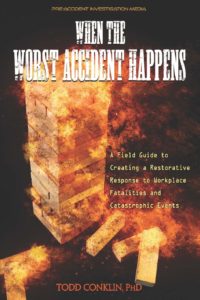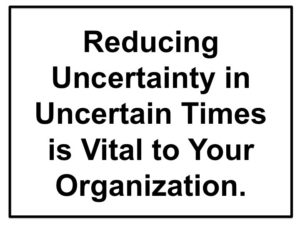Dr. Todd Conklin is an icon in the Safety & Health industry. His ability to craft intelligent messages in terms people can understand has won him acclaim. We at SafetyStratus are pleased to share with you an excerpt from his sixth book: When the Worst Accident Happens. This is a rare treat since the book has yet to be published!
In the book, Dr. Conklin provides insights into the aftermath of a workplace fatality. These situations are fraught with turmoil but the stages of response are predictable.
Read below as we reveal Chapter 4 from Dr. Conklin’s new book.
Chapter Four
The Shock – Confidence is in Question
“I have no faith we won’t kill someone tomorrow…”
A senior leader, privately speaking, after several fatal events in two-weeks
A catastrophic failure like a fatality or a serious event is called a “hinge event.” This type of serious event will become the point at which your organization and its operations will change. It is my hope the change that happens within an organization is a change for the good; the organization gets smarter and better. However, a hinge event does not automatically create positive outcomes. This type of event may also permanently harm your operations, your leadership, your trust, and your organizational culture. The shock your organization feels during and after this hinge event is an important moment for your operational future.
The immediate response to a horrible event is almost always led by an internal belief that an event of this seriousness is simply not possible, denial – which is normal and predictable. This is the worst thing that can happen in your workplace and it happened suddenly, without warning, and trust in the ability for people to feel safe and cared for has been abruptly torn asunder.
“We are a good organization. We don’t hurt people. We don’t kill people. We are safe. We care about our workers.” It is incredibly sobering to realize that somehow, some way our company just had a horrible event. This type of event is embarrassing and awful. This type of thing does not happen here and it does not happen to me. Yet, this type of event did happen and now we are forced to respond and react. Nothing about this notification, nothing about this shock is desirable, nothing.
What happens when the theoretical discussion of risk becomes an actual conversation of a horrible event? Risk discussions are most often separate from reality. Risk is always a potential outcome when we discuss operational and safety risk with our leadership teams and our workers. When the discussion of risk stops being an academic study in probability and becomes an actual unwanted outcome – the level of discomfort and unacceptability is extremely uncomfortable. When risk becomes an event – we are no longer living in a world of bad possibilities, we are living in a world of bad outcomes.
There is a belief that if a worker is killed in a horrible event somehow the worker must have failed the organizational system and processes – usually by not following some rule, process, or procedure. In fact, we find that in many, if not most cases, the organizational systems and processes somehow failed the worker. None of this discussion is comforting to your organization’s leadership.
Managers, leaders, and co-workers will be in shock. This type of notification is shocking news. Be aware of the immediate influence that the shock of a catastrophic event has on the organization’s ability to function – organizations tend to move internally, become secretive, hold information, assign blame, and respond ineffectively. Your organization will not be in normal mode – in fact it is predictable the organization becomes self-critical and somber. The realization that a bad thing has happened is a sad time and the faith the organization has in its ability to perform high-risk work safely has now been seriously questioned by an actual event. This is no longer the worst-case scenario, this is an actual outcome, and in a very real way, the operational confidence that is so vital to keep production going during normal times has been violently discredited (if only temporarily). Our basic belief in how we do our work has been torn from our operational understanding of our organization.
If your organization does not believe it can perform high-risk work safely, the organization will be in an “upset-mode” of operations. If your organization’s leadership does not believe they are leading a stable organization with stable and predictable operational outcomes, their lack of confidence in operations and production will be very apparent in their ability to move forward toward recovery.
This shock is very real. This loss of confidence is real. The uncertainty that every level of your organization will feel in doing work safely is also real. Knowing this uncertainty exists is important to knowing how to respond. Many times senior leaders have confided in me their lack of confidence in their own leadership. This type of an event is clearly the worst possible failure an organization can have. Your organization will need time and conversation space to begin to address how people are feeling about this horrible event. Without taking some time to talk about how people are feeling, your organization will be left to “put on a strong face and carry on.” Faking your way through this loss of confidence simply is not the best tactic – it does mean you don’t have to have awkward conversations about how people feel – but it does not mean you won’t have to have those conversations later.
When a shock like this happens, and sadly shocks like this happen all the time, people will respond quite predictably. The human reaction to a significant loss has been carefully studied in order to better understand and predict what the future state of your workers, leaders, and the organization as a whole will be feeling and thinking. Thanks to some important thinking about how people will respond to a loss, we have a roadmap of sorts that is extremely helpful in both understanding and preparing your organization for what is about to happen next.
Elisabeth Kübler-Ross was a Swiss-American psychologist who throughout her career studied grief. Her work was specifically around human loss by death. Her work is important in that she defined the stages of grief that a person will experience when someone close to them dies. Her book On Death and Dying is considered the most important work on grief ever written. Her studies allowed both researchers and practitioners the benefit of understanding the 5 predictable stages of grief.
Remarkably, these five stages of grief are also observable at an organizational level as well. There are clear points in time when your organization, and more importantly for our discussion your organization’s leadership team, will predictably and observably go through the five stages of grief. In a very real way, your organization will be grieving for the workers who were harmed, the people who work in the organization, and for the organization, itself.
Knowing these grief stages is helpful in understanding how to best provide support and guidance for your organization. There is not much you
I have taken the original Stages of Grief for individuals from Kübler-Ross’ seminal work and have added the analogous organizational Stages of Grief to provide some additional indicators of the expected cultural impacts by name. These organizational stages of grief are almost certain to happen within your organization. You will see direct examples of all five stages usually in the same order they are listed in Kübler-Ross’ theory.
Stages of Individual/Organizational Grief:
- Denial/Disbelief
- Anger/Blame
- Depression/Operational Uncertainty
- Bargaining/New Rules & Procedures
- Acceptance/Learning & Improving
Unfortunately, as I stated earlier in our conversation, I often serve as a peer on fatality and serious investigations in other organizations around the globe. When I enter the facilities where events have happened, it is quite easy to determine where the organization is on this grief journey. Knowing where the organization is often helps me understand what will be happening next. It is difficult to help an organization move towards event learning and restoration before the group has gone through the other four stages.
Your organization will move through these five stages exactly the same way in exactly the same order. Your organization will move, methodically through these five stages. You can count on it. The tempo by which the organization will move through these stages of grief is greatly dependent upon the maturity of the organization and on the amount of trust, psychological safety, and effective communication that has been exhibited and fostered during this difficult time.
As you are beginning to understand, restoration of organizational confidence starts almost immediately upon the exposure of the horrible event and its consequences. Timing matters greatly and how you communicate and build trust will greatly influence the organization’s ability to recover effectively.
Ask Leaders How They Are Doing
If you don’t debrief your staff and fellow co-workers at the time, your organization will have to have this conversation about how people are feeling later in order to move forward in your restorative actions. This is an example of paying now or paying later – and paying later will cost more effort and delay restoration of operational confidence. Here is the rule I try to follow: Have a conversation about operational confidence as close to the event (in both time and space) as possible.
Taking the time for workers and leaders to have a safe and private space to talk to each other and to talk about how they feel about this horrible event is extremely important. Encourage these people to talk about the way they are feeling. So far, the leaders and workers have probably been responding in a frantic, yet professional way. There probably has not been much time to talk about feelings and sadness. This conversation is important, especially for the leadership of your organization.
One powerful lesson I had to learn was the importance of debriefing the team that is deeply involved in responding and managing the restoration response to the catastrophic event. I was working with a team who were investigating and responding to a multi-worker fatality. The investigation process was very intense and involved. It is very difficult to recreate the mindset of several workers and carefully determine how such a horrific failure could happen. We spent a large amount of time working with the leadership of the organization. We didn’t spend much time talking to the investigators about how they were feeling and what they were doing to debrief this horrible event. Sadly, the lead investigator ended up divorced and eventually lost his job. The lead investigator never really recovered from this event. Horrible events are powerful interventions to the people who make up your organization. Take care to allow people to have the space to talk about how they feel about this event, the organization, and themselves. Fortunately, many organizations now provide post-traumatic stress debriefing (PTSD) and critical incident stress debriefing (CISD) resources for their workforces when an event transpires. This is a vital and important capacity to have in your organization, don’t ignore the possible need this service may have for your organization. Post-stress debriefing and additional care makes your organization a better place to work and the world a better place in total.
Your organization restoration strategy is all about the confidence your workers have in the overall organization being able to move forward, better and smarter. Think of the word confidence as a soft-replacement for the word trust. Trust and confidence are different words to be certain; confidence really is the foundation upon which trust is built in any organization. One cannot exist without the other. One of the most important tasks before you is to restore the confidence all of your workers (at any level of the organization) have in your organization.
I realize this is the part of significant event response that is not discussed much in our respective professions. Just because we don’t think about the softer side of a fatality response does not mean that the softer side doesn’t matter. The shock and the grief of an event of this caliber cannot simply be a technical matter, an engineering problem. This type of event has a large human cost. A major part of a restoration strategy is determining who has been hurt by this event. There will be pain at many levels of the organization.
About the Author:

Conklin holds a Ph.D. in organizational behavior from the University of New Mexico. He speaks all over the world to executives, groups and work teams who are interested in better understanding the relationship between the workers in the field and the organization’s systems, processes, and programs. He has brought these systems to major corporations around the world. Conklin practices these ideas not only in his own workplace, but also in the event investigations at other workplaces around the world. Conklin’s best selling book, Pre-Accident Investigations: An introduction to Organizational Safety is a best selling book on safety. Conklin has several other books and a huge podcast following for his twice-weekly podcast of the same name. Conklin defines safety at his workplace like this: “Safety is the ability for workers to be able to do work in a varying and unpredictable world.”
Conklin lives in Santa Fe, New Mexico and thinks that Human Performance is the most meaningful work he has ever had the opportunity to live and teach.





